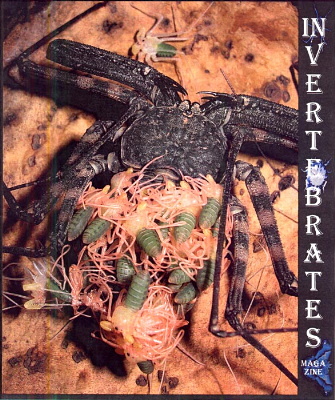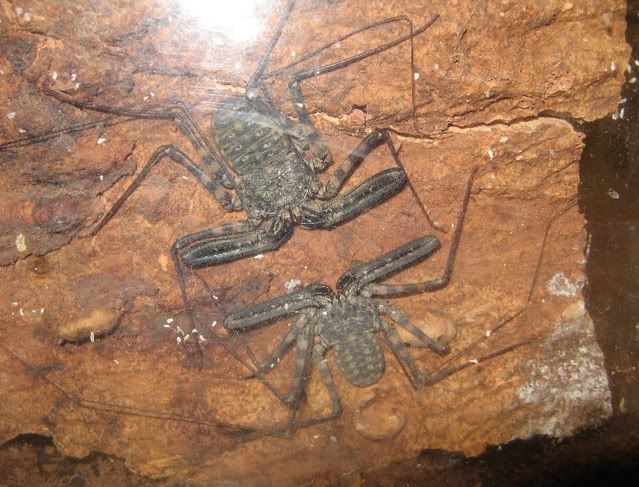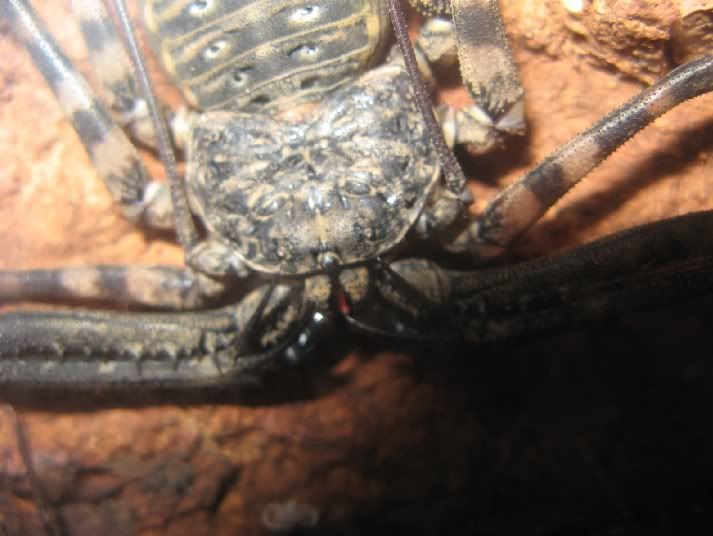Guest viewing limit reached
- You have reached the maximum number of guest views allowed
- Please register below to remove this limitation
- Already a member? Click here to login
You are using an out of date browser. It may not display this or other websites correctly.
You should upgrade or use an alternative browser.
You should upgrade or use an alternative browser.
Tailless whipscorpion from Costa Rica
- Thread starter Matt K
- Start date
Matt K
Eurycotis
Thanks, EffeCi, for the ID. The body of these guys was about 4 cm, maybe 3.5 cm, for a size reference. I was very suprised to see them (I had though such a thing only lived in Africa). But after seeing somethinglike this in the wild, I am tempted to get something similar domestically and set up a naturalistic habitat for them!It may be a Damon sp.A whip spider (amblypygio), not a whip scorpion (uropygio)
Does anyone know if whip spider (amblypygio) or whip scorpion (uropygio) can be kept in groups? Or are they normally solitary?
Most of them are not communal...but they will tolerate each others presence. Any that molt may be eaten. Perhaps with a really large enclosure it would work. The small species may be a better choice for these experiments.Thanks, EffeCi, for the ID. The body of these guys was about 4 cm, maybe 3.5 cm, for a size reference. I was very suprised to see them (I had though such a thing only lived in Africa). But after seeing somethinglike this in the wild, I am tempted to get something similar domestically and set up a naturalistic habitat for them!Does anyone know if whip spider (amblypygio) or whip scorpion (uropygio) can be kept in groups? Or are they normally solitary?
Females do care for their offspring up until they reach sexual maturity.
Amblypigids are known as tailless whipscorpions in the United States (approved common name AAS). It is not a scorpion so the name has to be whipscorpion (whip scorpion would denote a true scorpion such as butterfly and dragonfly are not flies versus a house fly). Damon is an Old World genus not found in Costa Rica. I can't see the pedipalp spines but the animal depicted is probably Paraphrynus laevifrons but is certianly from the genera Paraphrynus or Phrynus. As crittergu says they can be kept in groups but large ones will eat the small ones if hungry enough and similar sized individuals may eat each other at molts. Female only carry young through the first molt.


Matt K
Eurycotis
So what versions of this animal are available within the USA ?? I know that the Tanzanian one is around, but are there other New World neo-tropical or tropical varieties available? Now I wish I had taken more close-ups of the critters when I saw them.....!
I have several tarantula varieties that all seem to be in excellent health. That being said, my knowledge of arachnids is pretty weak in my opinion and limited to t's like Poecilotheria and Avicularia, Psalmopeus, and P.murinus, Aphonopelma and Lasiodora. I have a couple of scorpions, but have yet to really "figure them out" (Heterometrus sp.)
Orin- any suggestions ??
I have several tarantula varieties that all seem to be in excellent health. That being said, my knowledge of arachnids is pretty weak in my opinion and limited to t's like Poecilotheria and Avicularia, Psalmopeus, and P.murinus, Aphonopelma and Lasiodora. I have a couple of scorpions, but have yet to really "figure them out" (Heterometrus sp.)
Orin- any suggestions ??
Hi Matt,
Here's a link to photos of the two US species. I've kept them both. You might be able to order some of the AZ sp. from Hatari Invertebrates. You might ask Todd Gearheart for the Florida sp.
US Tailless Whipscorpions
Peter
Here's a link to photos of the two US species. I've kept them both. You might be able to order some of the AZ sp. from Hatari Invertebrates. You might ask Todd Gearheart for the Florida sp.
US Tailless Whipscorpions
Peter
Matt K
Eurycotis
I guess it just never occurred to me just how many species of these there are. Somehow I thought there were...5 maybe! A little web search shows me ALOT of varieties. Interesting.... still prefer roaches, but I may have to consider setting up some caging for a few of the tailless whipscorpions....
The ones from Florida and the ones from Hatari are both P.marginemaculata. The other species is also found in AZ but much more difficult to locate and last time Hatari had one a decade ago I bought it.
Perhaps I got the few AZ individuals I had from Aaron Chambers (former Hatari associate). I don't remember now...too many bugs, too many years agoThe ones from Florida and the ones from Hatari are both P.marginemaculata. The other species is also found in AZ but much more difficult to locate and last time Hatari had one a decade ago I bought it.
Peter
Last edited by a moderator:




